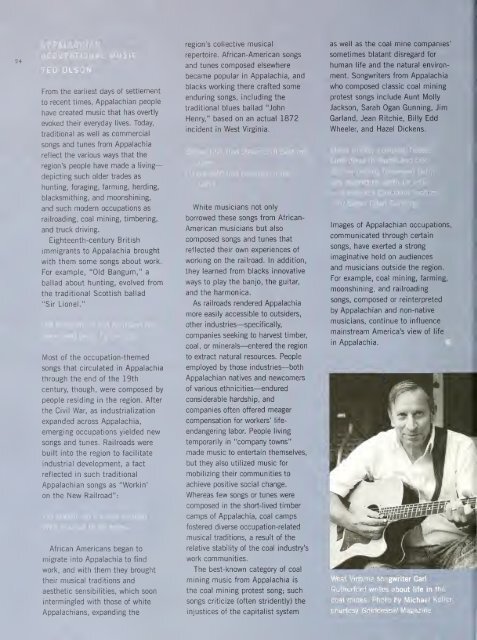SCOTLAND - Smithsonian Digital Repository - Smithsonian Institution
SCOTLAND - Smithsonian Digital Repository - Smithsonian Institution
SCOTLAND - Smithsonian Digital Repository - Smithsonian Institution
You also want an ePaper? Increase the reach of your titles
YUMPU automatically turns print PDFs into web optimized ePapers that Google loves.
—<br />
1 riate<br />
•KM ''&L'X^'Ttyi«iFi,i]V'Bk'<br />
region's collective musical<br />
as well as the coal mine companies'<br />
24<br />
OCCUPATIONAL IV1U<br />
TED OLSON<br />
repertoire. African-American songs<br />
and tunes composed elsewhere<br />
became popular in Appalachia, and<br />
sometimes blatant disregard for<br />
human life and the natural environment.<br />
Songwriters from Appalachia<br />
From the earliest days of settlement<br />
to recent times, Appalachian people<br />
have created music that has overtly<br />
evoked their everyday lives. Today,<br />
traditional as w/ell as commercial<br />
blacks working there crafted some<br />
enduring songs, including the<br />
traditional blues ballad "John<br />
Henry," based on an actual 1872<br />
incident in West Virginia.<br />
who composed classic coal mining<br />
protest songs include Aunt Molly<br />
Jackson, Sarah Ogan Gunning, Jim<br />
Garland, Jean Ritchie, Billy Edd<br />
Wheeler, and Hazel Dickens.<br />
songs and tunes from Appalachia<br />
reflect the various ways that the<br />
region's people have made a living<br />
depicting such older trades as<br />
hunting, foraging, farming, herding,<br />
blacksmithing, and moonshining,<br />
and such modern occupations as<br />
leftnafsteSiTt-::<br />
White musicians not only<br />
lese mignty company rasses,<br />
They dres- '-• ^^«"=!s and silk.<br />
But my c<br />
^e-eyed baby.<br />
•3d<br />
to death for mi<br />
the Capitalist Systeni<br />
XJ f^aeah Ogan Gni-ining<br />
railroading, coal mining, timbering,<br />
and truck driving.<br />
Eighteenth-century British<br />
immigrants to Appalachia brought<br />
with them some songs about w/ork.<br />
For example, "Old Bangum," a<br />
ballad about hunting, evolved from<br />
the traditional Scottish ballad<br />
"Sir Lionel."<br />
borrowed these songs from African-<br />
American musicians but also<br />
composed songs and tunes that<br />
reflected their own experiences of<br />
working on the railroad. In addition,<br />
they learned from blacks innovative<br />
ways to play the banjo, the guitar,<br />
and the harmonica.<br />
As railroads rendered Appalachia<br />
more easily accessible to outsiders,<br />
other industries—specifically,<br />
Images of Appalachian occupations,<br />
communicated through certain<br />
songs, have exerted a strong<br />
imaginative hold on audiences<br />
and musicians outside the region.<br />
For example, coal mining, farming,<br />
moonshining, and railroading<br />
songs, composed or reinterpreted<br />
by Appalachian and non-native<br />
musicians, continue to influence<br />
companies seeking to harvest timber,<br />
coal, or minerals—entered the region<br />
mainstream America's view of life<br />
in Appalachia.<br />
Most of the occupation-themed<br />
to extract natural resources. People<br />
songs that circulated in<br />
Appalachia<br />
employed by those industries—both<br />
through the end of the 19th<br />
Appalachian natives and newcomers<br />
century, though, were composed by<br />
of various ethnicities—endured<br />
people residing in<br />
the region. After<br />
considerable hardship, and<br />
the Civil<br />
War, as industrialization<br />
companies often offered meager<br />
expanded across Appalachia,<br />
compensation for workers' life-<br />
emerging occupations yielded new<br />
endangering labor.<br />
People living<br />
songs and tunes. Railroads were<br />
temporarily in<br />
"company towns"<br />
built into the region to facilitate<br />
made music to entertain themselves,<br />
industrial development, a fact<br />
but they also utilized music for<br />
reflected in<br />
such traditional<br />
mobilizing their communities to<br />
Appalachian songs as "Workin'<br />
achieve positive social change.<br />
on the New Railroad":<br />
Whereas few songs or tunes were<br />
composed in the short-lived timber<br />
camps of Appalachia, coal camps<br />
fostered diverse occupation-related<br />
musical traditions, a result of the<br />
African Americans began to<br />
relative stability of the coal industry's<br />
migrate into Appalachia to find<br />
work communities.<br />
work, and with them they brought<br />
The best-known category of coal<br />
their musical traditions and<br />
mining music from Appalachia is<br />
aesthetic sensibilities, which soon<br />
the coal mining protest song; such<br />
intermingled with those of white<br />
Appalachians, expanding the<br />
songs criticize (often stridently) the<br />
injustices of the capitalist system<br />
coal mines. Photo by Michael Keller,<br />
courtesy Goldenseal Magazine
















